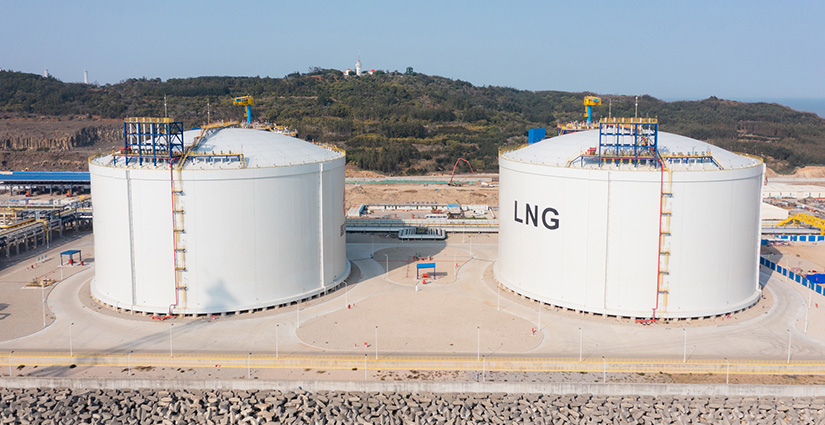Streamlined Life Cycle Assessments of Natural Gas Systems Can Inform Near-Term Energy Transition
New Open-Source SLiNG-GHG Model Provides Greater Understanding of Natural Gas Supply Chain

The natural gas industry is one of the largest greenhouse gas (GHG) emitters in the United States, and significant amounts of natural gas are used for electricity, heating, and industrial and chemical processes. Strategies like electrification of process equipment could cut GHG emissions in natural gas systems and accelerate transitioning today's energy system to 100% clean electricity by 2035.
"You need to understand the incumbent energy system when you're talking about an energy transition, especially in terms of greenhouse gas emissions benefits," said National Renewable Energy Laboratory (NREL) analyst Garvin Heath. "You have to understand the current system that you're transitioning away from in order to evolve."
Heath is among the authors on a new report, Charting the Course: Reducing Greenhouse Gas Emissions from the U.S. Natural Gas Supply Chain, conducted by the National Petroleum Council in response to a request from the secretary of the U.S. Department of Energy (DOE).
The report provides recommendations on how to reduce methane emissions based on a new open-source life cycle assessment model that examines natural gas and liquefied natural gas: the Streamlined Life Cycle Assessment of Natural Gas – Greenhouse Gases (SLiNG-GHG).
Streamlined Data for Natural Gas Life Cycle Assessments
To get the full picture of potential environmental impacts a technology or service may have over every stage of its lifetime, researchers use what is called life cycle assessment (LCA).
"One of the things that life cycle assessments do really well is to build up knowledge of every single step of a process and calculate the environmental costs each step could have versus the benefits it could have," Heath said.
LCAs of the natural gas supply chain examine the carbon footprint of acquisition of raw materials, manufacturing, product use, and disposal. This analysis requires massive amounts of information from hundreds of inputs.
The SLiNG-GHG model distills that information into just a few dozen parameters, giving users the ability to generate their own preliminary estimates about GHG emissions from natural gas and liquefied natural gas life cycles. Heath and researchers at McGill University (Montreal, Canada) co-led a small team of LCA experts from the National Petroleum Council study to develop the streamlined model through a meta-analysis, or harmonization, of LCA studies from the last decade, making it customizable for anyone to use.

"The idea is that the model can make tailored estimates for the particular supply chain, for a particular company, or in a particular region, because it varies quite considerably," Heath said.
As an open-source model, SLiNG-GHG is accessible to anyone and can help stakeholders at all points along the natural gas supply chain understand their greenhouse gas emissions. SLiNG-GHG can be valuable to government officials, investors, natural gas and liquefied natural gas producers and purchasers, and regulators outside of the federal government, to name a few.
Because the streamlined LCA data is available for every stage of the natural gas supply chain, stakeholders can prioritize the areas on which they would like to focus decarbonization efforts more easily.
"You can understand where to focus your efforts once you've looked across the whole system in detail," Heath said. "You can examine them all and say, 'This is the biggest one we want to put our decarbonization effort toward,' or, 'We have a great technology to decarbonize this section.'"
Informed Decision-Making: Next Steps
Ultimately, the goal of the SLiNG-GHG model is to encourage stakeholders at all levels of the supply chain to more frequently incorporate natural gas LCA data in planning and policy.
To that end, the National Petroleum Council study laid out several recommendations for planning and policy based on the findings, many of which are directly tied to the team's work and the chapter with which Heath was involved.
"Several recommendations revolve around the potential future and expanded uses of the SLiNG-GHG model, which could be very beneficial to not only the policymakers and DOE but also any user in the natural gas supply chain when it comes to determining the potential impacts of greenhouse gases in the future," Heath said.
The recommendations include the following:
- Stakeholders should use LCA models like SLiNG-GHG to determine the impact and potential opportunities to mitigate GHGs at all points in the supply chain.
- Stakeholders should adopt wider use of the SLiNG-GHG model for initial screening tests for natural gas carbon footprint estimates.
- DOE should support models such as SLiNG-GHG in its Measuring, Monitoring, Reporting, and Verifying efforts.
- Users should review the harmonization process when evaluating LCA data from other studies, and DOE should create best practice guidelines for natural gas LCAs.
- DOE should sponsor research and development of LCA tools designed to test the intensities of GHG emissions in various supply chains and pathways.
- DOE should sponsor the creation of an expert stakeholder advisory group to create further recommendations on the integration of GHG emissions measurement data.
- DOE should sponsor development of LCA models consistent with existing frameworks supporting GHG impact analysis of future natural gas use compared to other energy sources.
Read more about natural gas life cycle assessments, and learn more about NREL's energy analysis research.
Last Updated May 28, 2025
